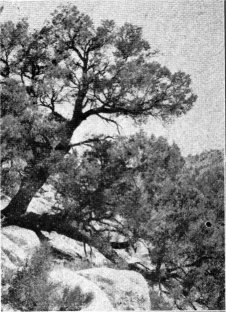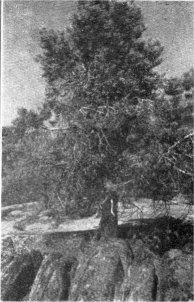
[click to enlarge]
| Online Library: | Title | Author | California | Geology | History | Indians | Muir | Mountaineering | Nature | Management |
Yosemite > Library > Cone-bearing Trees > Single-leaf Pine >
Next: White Fir • Contents • Previous: Lodgepole Pine
Pinus monophylla Torrey and Fremont.

[click to enlarge] |
This pine, like many others, is known by several names, the most common being probably Nut Pine or Pinon. The name Nut Pine is appropriate because of the large quantity and fine quality of seed kernels which provided the Indians with an abundant supply of nourishing food. The name, Pinon Pine, is not so fitting since the true Pinon Pine is a well-known tree of the Southwest and Mexico. It is from that species that the pinon nuts of commerce are obtained. Certainly the desirable common name is Single-leaf Pine for such a name calls attention to the most distinctive identification mark —the single arrangement of the needles. The scientific name, Pinus monophylla, means literally a pine with single (mono) leaves (phylla). The Single-leaf Pines are essentially trees of arid, foothill regions of Arizona, Utah and Nevada, but extend westward to the eastern face of the Sierra Nevada in California where they are rather common between elevations of 4000 and 9000 feet from Alpine County south to Kern County. On the western slope of the Sierra, they occur in a few restricted, although widely scattered localities. The northernmost of these outpost stations was found by Park Naturalist C. A. Harwell in 1936. It is on a granite ridge between Tiltill Valley and Rancheria Creek overlooking Hetch Hetchy Reservoir. Here there is a grove some two acres in extent and comprising about 100 trees which establishes Single-leaf Pines as bona-fide elements f the forests of Yosemite. Prior to the discovery of this grove this species was known to occur in the park only as single specimens on Paiute Creek in Muir Gorge and on Rancheria Mountain.

[click to enlarge] |
Few visitors to Yosemite, however, will have an opportunity to see this species growing in the park as no road leads to it. Nevertheless, visitors who enter the park from the east or leave by the Tioga Road, will encounter Single-leaf Pines on the mountains along the sharp eastern escarpment of the Sierra Nevada. There they can be recognized even at considerable distances by their low, flat-topped, or round-headed forms that look like old apple trees. Never tall trees, generally less than twenty-five feet high, they of all Yosemite pines exhibit to the fullest extent a habit that is quite unlike other members of this genus. Like the Digger and Knobcone Pines, also typical residents of the foothill regions, the Single-leaf Pines have branched trunks which are frequently bent and crooked. The trees have short, heavy, twisted branches that droop nearly to the ground so that in form they scarcely look as much like pines as small oaks. The trees are so distantly and regularly spaced that they resemble old orchards.
This unorthodox condition is further augmented when the foliage is examined for the single needles confuse many people who are not aware that there are pines with such leaves. The single yellow-green leaves will average one and one-half inches in length, and are cylindrical, spiny, stiff and curve upward.
In one aspect, Single-leaf Pines differ from the other pine denizens of the hot foothills. Both the Digger and Knobcone Pines are short-lived trees seldom attaining ages of 100 years. The slow-growing Single-leaf Pines, however, average well over 100 years at maturity and occasionally are found as old as 225 years. The usual diameter of the trunks throughout the general range is between twelve and fifteen inches, although in protected, fertile situations it may be larger. With the discovery of the grove of Single-leaf Pines in Yosemite, a new trunk diameter record is established; one of these trees is forty-nine inches across. This tree is 43 feet high and has a spread of 57 feet. A core sample taken five and one-half feet above the ground showed a ring count of 250 years. It is in good company and so sets its mark in a region of large trees for Yosemite National Park is preeminently an area of record sized trees.
Next: White Fir • Contents • Previous: Lodgepole Pine
| Online Library: | Title | Author | California | Geology | History | Indians | Muir | Mountaineering | Nature | Management |
http://www.yosemite.ca.us/library/cone-bearing_trees/single-leaf_pine.html